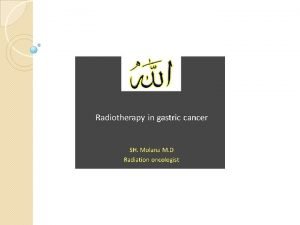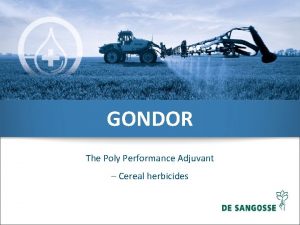P 51 Neoadjuvant versus adjuvant chemotherapy in advanced

- Slides: 1

P 51 Neo-adjuvant versus adjuvant chemotherapy in advanced ovarian carcinoma Logo Hanan Ramadan Nassar M. D. ¹, Ihab Samy Fayek M. D. ¹ , Alfred Elias Namour M. D. ¹ Mostafa Maher El-Gammal MSc² ¹ National Cancer Institute, Cairo University, ²Agouza police hospital , ministry of interior , Egypt Introduction Ovarian Cancer Results Patients with advanced ovarian cancer should be treated by radical * Globally 7 th most incident and lethal cancer debulking surgery aiming at complete tumor resection. Neoadjuvant New cases: 225, 000 annually chemotherapy (NACT) has been proposed as a novel therapeutic Deaths: 140, 000 annually approach in such cases. *Almost 75% of cases present with advanced stage. *Risk of relapse of advanced stage disease is as high as 70% Current Standard of Care Overall survival Both the American and European guidelines recommend surgery as the initial approach to The median overall survival time was 45. 77 months in the conventional group and 49. 06 month in the NACT group with P value (P = 0. 329) fig 1. ovarian malignancies . However, interval debulking surgery (IDS) has progressively become more popular. Disease free survival The median disease free survival was 37. 35 months in the conventional group and 43. 45 months in the NACT group with P value (P = 0. 609) fig 2. Aim of work This retrospective study was to assess whethere is an advantage of treating women with advanced ovarian cancer with neoadjuvant chemotherapy (NACT) compared with conventional treatment where chemotherapy follows primary cyto-reductive surgery. Figure #1 Overall survival Figure #2 Disease free survival Research question In patients with advanced ovarian cancer, is neoadjuvant chemotherapy more effective than adjuvant chemotherapy? Methods CHART or PICTURE Study Design This is a retrospective study Include a total of 60 patients with stage III or IV epithelial ovarian carcinomas were evaluated between 2009 and 2015. All patients were submitted to debulking surgery with optimal cytoreduction R 0. Neoadjuvant chemotherapy was given (in 30 patients). Conversely primary debulking surgery was performed (in 30 patients). Patient's Characteristics A total of 60 patients divided into 2 groups according to pattern of treatment. Conclusions Patterns of treatment Neoadjuvant 6 cycles taxol carboplatin then Neoadjuvant 6 cycles cytoreductive surgery taxol carboplatin then 2 cycles 6 cycles taxol cytoreductive surgery carboplatin 13% 2% 3% Adjuvant cytoreductive surgery then 6 cycles taxol carboplatin 50% *Neoadjuvant chemotherapy followed by interval debulking surgery was not inferior to primary debulking surgery. *Primary chemotherapy followed by interval debulking surgery in select group of patients doesn't appear to worsen the prognosis, but it permits a less aggressive surgery to be performed. Neoadjuvant 3 cycles taxol carboplatin then cytoreductive surgery then 3 cycles taxol carboplatin 32% Outcome Primary: Overall survival calculated from date of presentation till date of death or last follow up. Secondary: Disease free survival calculated from date of initial treatment till date of relapse or death or last follow up Bibliography 1 -American Cancer Society. Cancer Facts and Figures 2015. Atlanta, GA: American Cancer Society; 2015. 2 -Kehoe S, Hook J, Nankivell M, et al. (2013), Chemotherapy or upfront surgery for newly diagnosed advanced ovarian cancer: Results from the MRC CHORUS trial. J Clin Oncol 31, (suppl; abstr 5500). 3 -NICE (2011). Ovarian Cancer: The recognition and initial management of ovarian cancer. Clinical Guidelines [CG 122].

